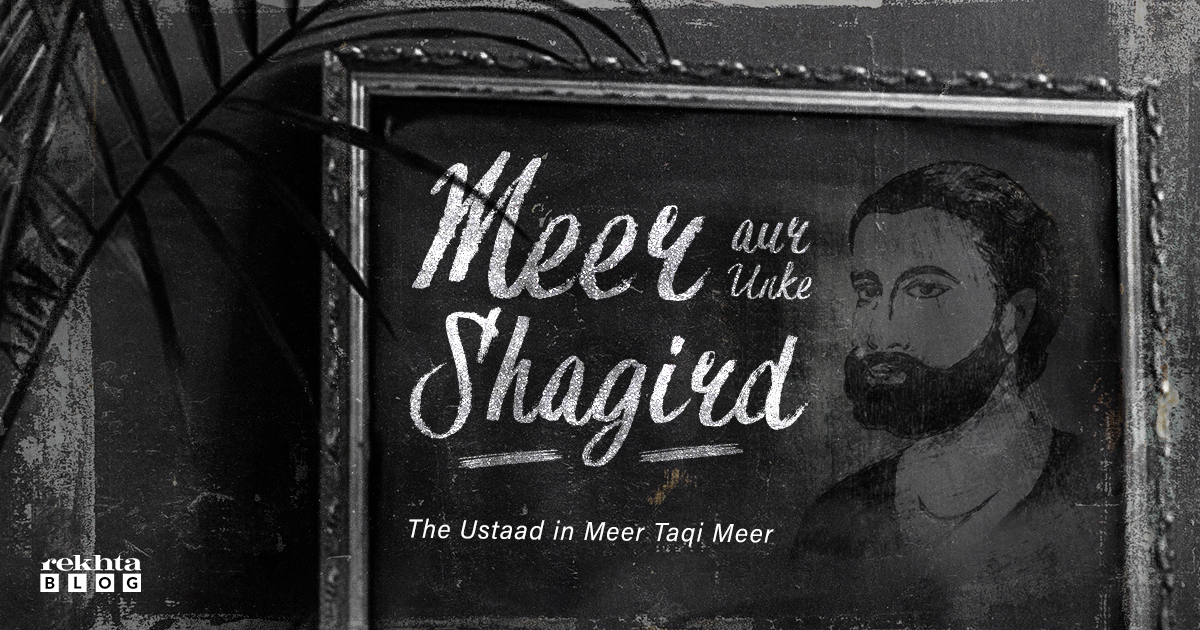
Meer aur Unke Shagird: The Ustad in Meer Taqi Meer
Teacher’s day is quite a reminder as to why we should never forget what our teachers did for us. The same can be said for Urdu poetry where the tradition of Ustad and Shagird is both a legacy and a legend. Each of our favorite poets, at some point in time, reached out to their Ustads for corrections and amendments in their works, it’s a kind of unwritten law, one that is seldom read these days.
The importance of a teacher can be weighed by the following shloka of Bhagvad Gita, it’s the introductory verse where Arjuna supplicates Krishna to bestow upon him the reality of existence:
Agyantimirandhasya Gyananjana-shalakaya:
Chakshurunmiilitam yain tasmai shri guruve nama:
He who shows the torch of enlightenment, to me, the ignorant, darkness-born
He who opens my eyes to Truth, salutations, unto that Holy Guru
While I was planning to write this blog, I thought to myself ‘which poet should I write about?’ The answer came to me in the most bizarre ways of all, while binging upon one of Jashn-e-Rekhta’s yesteryear’s sessions on You Tube, I came across one dedicated to Allama Iqbal. Wherein, Prof. Anisur Rahman quoted a phrase remarked to him years ago by Prof. Shamim Hanafi, ‘Ghalib bade shair hain, magar Mir, ustaad hain’.
The comment almost instantly erased the dilemma, ‘who else but Mir, Urdu’s Khuda-e-Sukhan’, I thought. Mir had many pupils, but not as many as Mushafi, Nasir, or Insha. Partly because of his delicate temper and reserved disposition, and partly because it was quite a task for poets to get to Mir. So, the ones who’ve made it deserve genuine praise, I suppose!
Another reason why Mir’s masterfulness becomes interesting is that the islaah, or corrections made by him offer a little peak into the cerebral craftsman in him. Little changes adding many aspects to the verse, Mir’s craft as an Ustad is worthy of an academic research as well.
Let’s flash on some of Mir’s shagirds, a few anecdotes about them, and their rapport with Mir as their Ustad.
Parwana
One of Mir’s earliest pupils, Parwana, born Raja Jaswant Singh, had a Persian Diwan of over 2000 couplets and the same was the case with the one in Urdu. His wit and wisdom impressed his Ustad the most.
Once he went to meet Shaikh Ali Hazin, he sent for his arrival and Hazin sent a slip with the following hemistich written in Persian:
darii.n bazm rah niist begaana ra (In this gathering, there’s no entry to a stranger)
Parwana sent his answer by adding another hemistich impromptu:
ki parwaanagi daad parwaana ra (So, grant permission, to the Parwaana)
Anyone would be impressed by such imaginativeness, let alone Mir! Coming back to Mir’s Ustad-ship, he provided correction to one of Parwaana’s famous couplets:
Kahti hai andaleeb chaman mein pukaar ke
Apne bhi din bharen jo bharen din bahaar ke
The couplet originally had ‘kahti thi andalib’, Meer changed it to ‘Kahti hai’, which perhaps explains why this couplet is still calling out! Poor nightingale’s days are not over!
Rasikh Azimabadi
Shaikh Ghulam Ali Rasikh’s story of becoming Mir’s pupil is quite interesting. When he stepped into Delhi, he was a complete stranger, only a long-lost uncle of his knew him. One day, he contrived to send a couplet through his Mamu to Mir, the couplet was:
Khak hoon partaw nahin hoon chashm-e-mehr-o-maah kaa
Aankh waala rasta samjhe hai ghubaar-e-raah kaa
Mir was so moved by reading this couplet that he came running out of his house and hugged him, Rasikh told Mir that he seeks his tutelage, Mir wondered that a person of such craft and learning needed no Ustad, but at the former’s earnest insisting he agreed to rectify his writings. A couplet of Rasikh which was amended by Mir:
Marte dam un ka zikr jab aaya zabaan par
Neend aa gayi hamen tab usi daastaan par
Mir reframed the above verse in this way:
Ta-Khwab-e-Marg zikr tha un ka zabaan par
Neend aa gayi hamein to usi daastan par
Mir handed his Divan to Rasikh and said, ‘ab yahi tumhari islaah karega’.
Majnun
A Dervish who used to stroll naked in the streets, bald, barefooted, having severed all ties from the material world, this was Majnun, quite literally! His only bent was poetry, and Mir took him under his wing for his Faqirana temperament, which quite resembled Mir’s own nature. One of Majnun’s couplets in which Mir made amends:
Piya nahin qadh-e-mai ko main kabhu tujh bin
Raha mudaam (hamesha) mere jaam mein lahu tujh bin
Mir did a masterly touch-up to the verse. Originally, the verse had the word ‘hamesha’ instead of ‘mudaam’, but Mir changed it to the latter, which both went better with the meter and added a bit of clever wordplay to the verse, for ‘mudaam’ also means drinking wine. Welcome, dear reader, to classical Urdu Shayari!
Mir Kallu Arsh
Born Syed Muhammad Askari, he was the son of Mir Taqi Mir, some memoirs, while comparing the father son duo unanimously assert, ‘Mir Kallu Arsh was black in complexion, short-heighted, and as meek as malnourished, it seemed as if Mir Taqi Mir well might have seen days of pleasure and delight, but the same cannot be said about his son’.
For a time, there was also this misunderstanding that Arsh was the pupil of Nasikh, but soon the air swept away. Why go to Nasikh, when you’ve got Mir at your home!
Coming back to the poetry, Arsh had the distinction of being trained and fostered by none other than Mir Taqi Mir. He sought corrections and suggestions by his father, who, certainly rectified for better:
Dil na le aye sanam bara-e-Khuda
Kuchh (kih) bahalta hai isse ji mera
Mir, again quite craftily, just changed the word ‘kih’ to ‘kuchh’, both concealing and divulging the meaning at the same time, establishing his masterfulness, well, again!
To end this teacher’s day special, let’s revisit a couplet which brings out Mir’s own view of his Ustad:
mire ustaad ko firdaus-e-aala mein mile jagah
padhaya kuch na ghair-az-ishq mujh ko khwurd-saali mein
NEWSLETTER
Enter your email address to follow this blog and receive notification of new posts.




